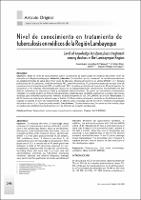Nivel de conocimiento en tratamiento de tuberculosis en médicos de la Región Lambayeque
Related Resource(s)
http://cmhnaaa.org.pe/ojs/index.php/rcmhnaaa/article/view/731Date
2020-12-12Author(s)
Longobardi Vásquez, Guadalupe
Díaz Vélez, Cristian
Villegas Chiroque, Miguel
Metadata
Show full item recordAlternate title
Level of knowledge in tuberculosis treatment among doctors in the Lambayeque Region
Abstract
Objetivo. Medir el nivel de conocimientos sobre tratamiento de tuberculosis en médicos del primer nivel de atención en la Región Lambayeque. Material y Métodos: Estudio descriptivo, trasversal. Se recolectaron datos en los establecimientos de salud del primer nivel de atención. Tamaño de muestra: se utilizó EPIDAT v 3.1; tamaño poblacional de 221 personas, nivel de confianza 95%, precisión absoluta 5%, proporción esperada de bajo nivel de conocimiento en tratamiento de TBC en médicos del 27%; se obtuvo un tamaño de muestra de 97 participantes. Se incluyeron a 113 médicos seleccionados por muestreo no probabilístico por conveniencia, excluyéndose los que laboren solamente en atención privada y actividades administrativas. Se aplicó un instrumento previamente validado. Se realizó análisis de frecuencias absolutas y relativas para variables cualitativas y media y desviación estándar para variables cuantitativas. Además, el análisis inferencial con Chi2 y ANOVA con p<0,05. Resultados: El 60,2% tienen una experiencia laboral mayor a 5 años; 43,4% atendieron al menos 1 paciente en los últimos 6 meses. Cuando se analizó el nivel de conocimiento se obtuvo como resultado que de los 64/113 médicos encuestados obtuvieron entre 11 y 15 puntos (nivel medio). Conclusiones: El conocimiento más frecuente es nivel medio y bajo en médicos de establecimiento de primer nivel de atención de la región Lambayeque. Objetive. To measure the level of knowledge about treatment of tuberculosis in doctors of the first level of care in the Lambayeque Region. Material and Methods: Descriptive, cross-sectional study. Data were collected in health facilities at the first level of care. Sample size: EPIDATv 3.1 was used: population size of 221 persons, 95%confidencelevel,5absoluteprecision%,An expected low level of knowledge in treatment of TB in physicians of 27%; Asample size of 97 participants was obtained. Atotal of 113 physicians selected for non-probabilistic sampling were included for convenience, excluding those who work only in private care and administrativeactivities.Aninstrumentpreviously validated. Absolute and relative frequency analyzes were performed for qualitative and mean variables and standarddeviationforquantitativevariables.In addition, the inferential analysis with Chi2 and ANOVAwith p <0.05. Results:60.2% have a work experience of more than 5 years; 43.4% attended at least 1 patient in the last 6 months. When the level of knowledge was analyzed, it was obtained that of the 64/113 doctors surveyed obtained between 11 and 15 points (average level). Conclusions:The knowledge more frequent is medium and low level in doctors of first level care of the Lambayeque region.






